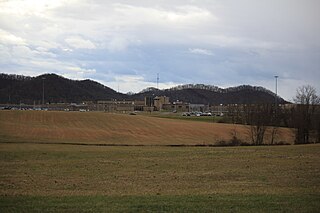
Solitary confinement is a form of imprisonment in which the inmate lives in a single cell with little or no contact with other people. A prison may enforce stricter measures to control contraband on a solitary prisoner and use additional security equipment in comparison to the general prison population. Solitary confinement is a punitive tool within the prison system to discipline or separate disruptive prison inmates who are security risks to other inmates, the prison staff, or the prison itself. However, solitary confinement is also used to protect inmates whose safety is threatened by other inmates by separating them from the general population.

The Attica Prison Riot, also known as the Attica Prison Rebellion, the Attica Uprising, or the Attica Prison Massacre, took place at the state prison in Attica, New York; it started on September 9, 1971, and ended on September 13 with the highest number of fatalities in the history of United States prison uprisings. Of the 44 men who died, all but one guard and three inmates were killed by law enforcement gunfire when the state retook control of the prison on the final day of the uprising. The Attica Uprising has been described as a historic event in the prisoners' rights movement.

The Arizona Department of Corrections, Rehabilitation & Reentry, commonly and formerly referred to as simply the Arizona Department of Corrections, is the statutory law enforcement agency responsible for the incarceration of inmates in 13 prisons in the U.S. state of Arizona. As of December 2015, the ADC manages over 42,643 imprisoned inmates and over 5,466 inmates who have been paroled or that are statutorily released. ADC is also in involved in recruitment and training of Correctional Officers at the Correctional Officer Training Academy (COTA) in Tucson, Arizona. The ADC is headquartered in Downtown Phoenix.

Mountjoy Prison, founded as Mountjoy Gaol and nicknamed The Joy, is a medium security men's prison located in Phibsborough in the centre of Dublin, Ireland. The current prison Governor is Edward Mullins.

CoreCivic, formerly the Corrections Corporation of America (CCA), is a company that owns and manages private prisons and detention centers and operates others on a concession basis. Co-founded in 1983 in Nashville, Tennessee by Thomas W. Beasley, Robert Crants, and T. Don Hutto, it received investments from the Tennessee Valley Authority, Vanderbilt University, and Jack C. Massey, the founder of Hospital Corporation of America.
A prison riot is an act of concerted defiance or disorder by a group of prisoners against the prison administrators, prison officers, or other groups of prisoners.

The Carandiru massacre occurred on Friday, 2 October 1992, in Carandiru Penitentiary in São Paulo, Brazil, when military police stormed the penitentiary following a prison riot. The massacre, which left 111 prisoners dead, is considered by many people to be a major human rights violation.

Pul-e-Charkhi Prison, also known as the Afghan National Detention Facility, is a maximum security prison located next to the Ahmad Shah Baba Mina neighborhood in the eastern part of Kabul, Afghanistan. It has the capacity to house between 5,000 and 14,000 inmates, but as of February 2023 it only has between 2,000 and 2,500 inmates, most of whom have been arrested and convicted within the jurisdiction of Kabul Province. It is considered the country's largest prison.

The Metropolitan Detention Center, Brooklyn is a United States federal administrative detention facility in the Sunset Park neighborhood of Brooklyn, New York City. It holds male and female prisoners of all security levels. It is operated by the Federal Bureau of Prisons, a division of the United States Department of Justice.

The Southern Ohio Correctional Facility is a maximum security prison located just outside Lucasville in Scioto County, Ohio. The prison was constructed in 1972. As of 2022, the warden is Donald Redwood.

The United States Penitentiary, Atlanta is a low-security United States federal prison for male inmates in Atlanta, Georgia. It is operated by the Federal Bureau of Prisons, a division of the United States Department of Justice. The facility also has a detention center for pretrial and holdover inmates, and a satellite prison camp for minimum-security male inmates.

The GEO Group, Inc. (GEO) is a publicly traded C corporation that invests in private prisons and mental health facilities in North America, Australia, South Africa, and the United Kingdom. Headquartered in Boca Raton, Florida, the company's facilities include illegal immigration detention centers, minimum security detention centers, and mental-health and residential-treatment facilities. It also operates government-owned facilities pursuant to management contracts. As of December 31, 2021, the company managed and/or owned 86,000 beds at 106 facilities. In 2019, agencies of the federal government of the United States generated 53% of the company's revenues. Up until 2021 the company was designated as a real estate investment trust, at which time the board of directors elected to reclassify as a C corporation under the stated goal of reducing the company's debt.
Management & Training Corporation or MTC is a contractor that manages private prisons and United States Job Corps centers, based in Centerville, Utah. MTC's core businesses are corrections, education and training, MTC medical, and economic & social development. MTC operates 21 correctional facilities in eight states. MTC also operates or partners in operating 22 of the 119 Job Corps centers across the country. They also operate in Great Britain, under the name MTCNovo.
The 1989 Polish prison riots refers to an outbreak of violence, which took place at four maximum-security prisons in northwestern Poland in late 1989. The riots were the result of political changes which had taken place in Poland in early and mid-1989. Inmates in several prisons hoped that collapse of the Communist system would result in the release of repeated offenders, due to an amnesty, but it did not happen. In the riots that ensued, seven people were killed, and hundreds were wounded.
Willacy County Correctional Center is a closed detention center located on the east side of Route 77, at the edge of Raymondville City, Willacy County, Texas, United States.
The 2018 U.S. prison strike was a series of work stoppages and hunger strikes in prisons across the United States that began on August 21 and ended on September 9. The strike was conducted at least in part in response to the April 2018 prison riot at Lee Correctional Institution, which killed seven inmates and was the deadliest prison riot in the U.S. in the past 25 years.

The COVID-19 pandemic has impacted prisons globally. There have been outbreaks of COVID-19 reported in prisons and jails around the world, with the housing density and population turnover of many prisons contributing to an increased risk of contracting the virus compared to the general population. Prison crowding and lack of sanitation measures contribute to the risk of contracting diseases in prisons and jails. As a mitigation measure, several jurisdictions have released prisoners to reduce density and attempt to reduce the spread of the illness. There have also been protests among prisoners, riots and prison breaks in multiple countries in response to prisoner anger over their risk of contracting illness in prison conditions. Before the COVID-19 pandemic, health services within prisons had issues providing adequate care for incarcerated people, and this has only been exacerbated by the impacts of COVID-19. Minority groups within the prison system have been disproportionately affected by the COVID-19 pandemic.
The 2010 Georgia prison strike was a prison strike involving prisoners at 7 prisons in the U.S. state of Georgia. The strike, organized by the prisoners using contraband cell phones, began on December 9 and ended on December 15. It was reported at the time to be the largest prison strike in United States history and was followed by similar strikes in several other states, as well as nationwide strikes several years later, in 2016 and 2018.














